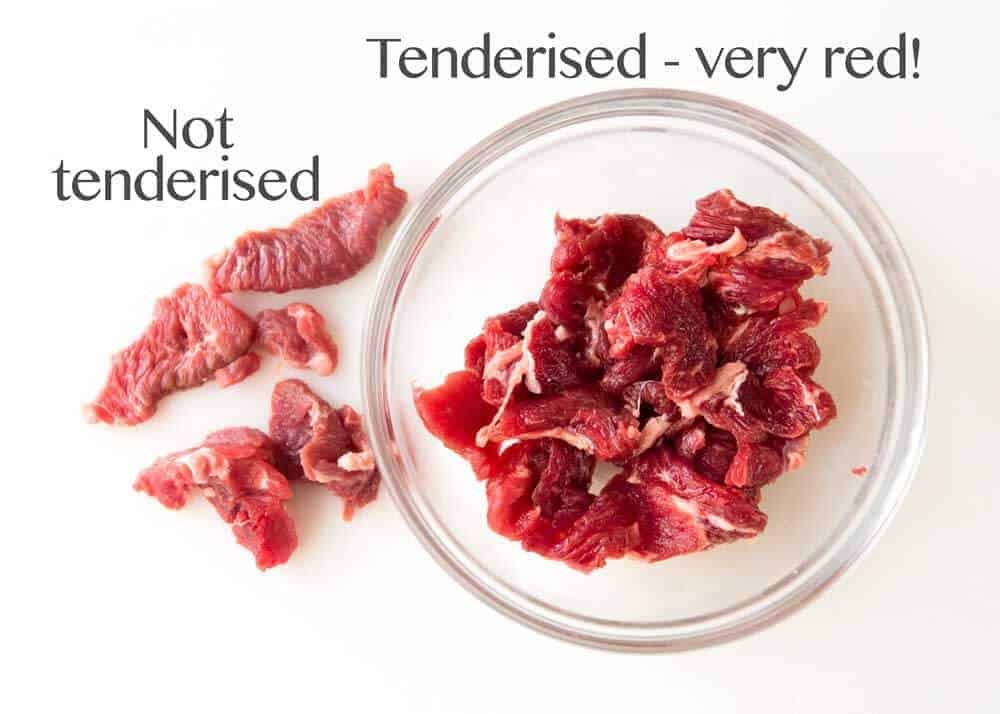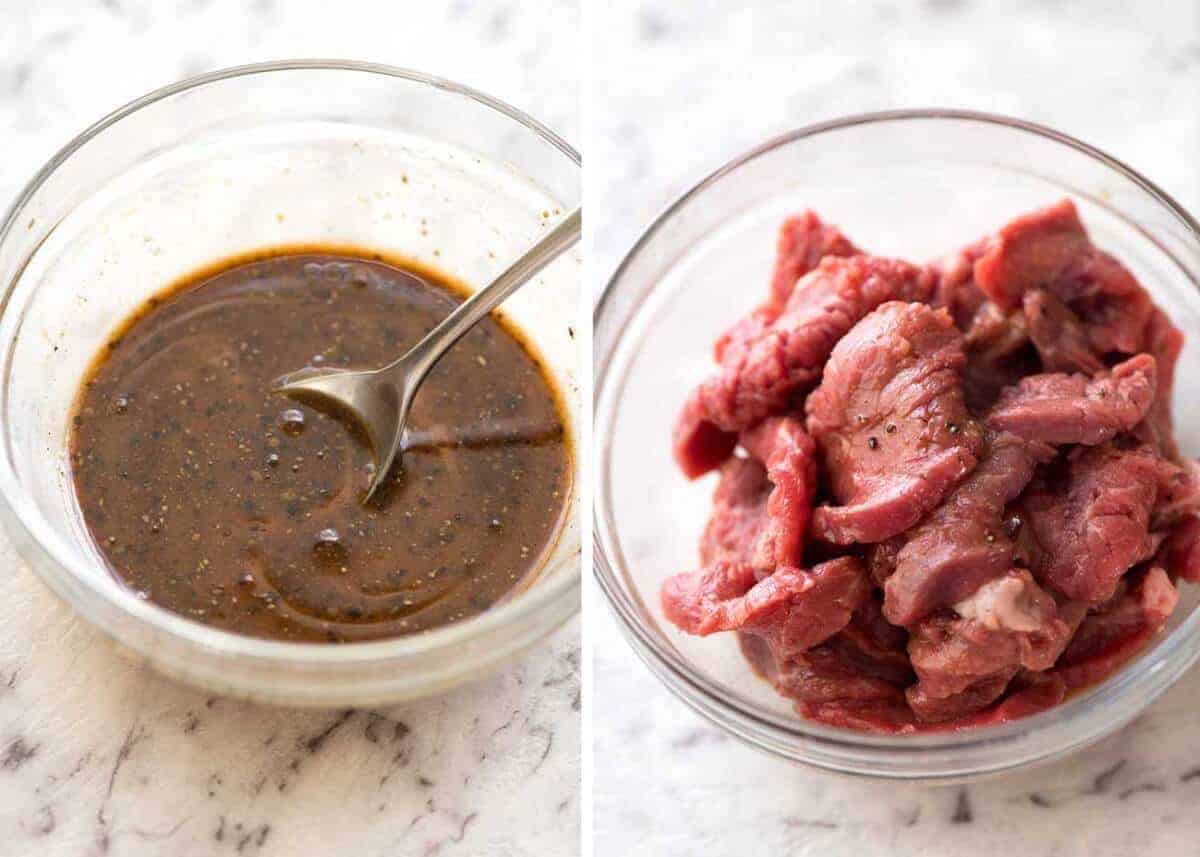How to Use Baking Soda to Tenderize Beef and Fajitas
This is how to tenderise beef with a Chinese restaurant method called "velveting beef". Also used for chicken, it's a simple, highly effective technique using baking soda that transforms economical beef so it's incredibly tender in stir fries and stir fried noodles.
It's a quick and easy method that any home cook can do, any night of the week. No deep frying, no special equipment. This is a game changer!


How do Chinese restaurants get their beef so tender??
Ever notice how the beef at Chinese restaurants is so incredibly tender, and how your stir fries at home are just never the same?
The secret is tenderising the meat. It's called velveting beef.
Your cheerful local Chinese restaurant is using economical stewing beef to make stir fries with ultra tender strips of beef by tenderising it!
How to tenderise beef – easily!
There are a few methods, but this is the easiest way:
-
Sprinkle 3/4 tsp baking soda (bi-carbonate soda) on 250g / 8oz sliced economical beef cuts
-
Toss with fingers, leave for 30 minutes
-
Rinse, pat off excess water
-
Proceed with stir fry recipe. It can be marinated with wet or dry seasonings, or cooked plain. The beef will be really tender and soft, "velvet' like. Just like in stir fries made by your favourite Chinese restaurant!
Other tenderising methods include marinating in a cornflour/cornstarch sludge then frying in oil before using in the stir fry, chemical tenderisers and egg white marinates. The baking soda method is the simplest for every day purposes and just as effectivewhich is why it's the method I use.

Beef cuts to tenderise
These are the best cuts of beef to tenderise:
-
economical steaks* – any type, like good value rump, porterhouse, sirloin, round bottom etc. that are otherwise quite dry when used in stir fries;
-
chuck and similar cuts of beef used for stews – this technique will tenderise the beef perfectly, however, by their very nature, stewing cuts of beef don't have as strong a natural beef flavour as steaks. However, I'm fine with that because stir fries always have great sauces!
* It sounds counterintuitive to tenderise steaks because one would assume if beef is sold labelled as "steaks", that indicates they're good for quick cooking (eg grilling) so it should be good for stir fries. But it's not – even steaks range from economical to high quality. You can use any high quality (expensive) steak in stir fries without tenderising (which is what fine dining Asian restaurants do). Use this tenderising technique on budget steaks, not expensive steaks.
Tenderising time
Tenderising timediffers for different cuts of beef. Here's the general rule of thumb I've come up with based on all the beef I've tried:
-
Chuck beef, gravy beef, oyster beef and other traditional stewing beef – 30 minutes
-
Economical steak cuts (eg. cheap rump, hanger) – 20 minutes
-
Blade, bolar blade – 40 minutes
-
Brisket – the only cut I don't recommend, haven't been 100% happy with outcome
If you're unsure for your cut of beef, go for 35 minutes. Even when I under or over tenderised, it was still tender and juicy. You'll quickly figure out the best marinating times for your preferred cuts of beef – just adjust up and down by 10 minutes at a time.
Word of caution: The beef will turn freakishly bright red. See?
Don't be alarmed – that's just what happens. In fact, if you put your ear very close to the beef, you'll hear faint fizzing – that's the baking soda at work!

Marinating Tenderised Beef
After it's been tenderised, go ahead and marinate it in whatever you want – wet sauce or dry seasonings. Because we're using thin slices of beef here and it's been tenderised, we don't need to marinate for long. Even 10 minutes will suffice.
Also, stir fries have the benefit of glossy sauces coating the beef so that's another reason why we do not need to marinate it for long.
Pictured below is the stir fry sauce / marinade for Chinese Beef and Broccoli.

How to cook tenderised beef
Tenderised beef can be stir fried the traditional way – hard and fast on a hot stove in mere minutes – or even deep or shallow fried in oil like in this Crispy Mongolian Beef (pictured below).
Whichever way you cook it, the beef comes out much more tender and juicy than even expensive cuts of beef like beef tenderloin!
What does tenderised beef taste like?
The flavour of the beef is not affected by the tenderising. So the beef flavour will only be as good as the cut you use.
Tenderising affects thetexture not the flavour of the beef. It has a "velvety" texture. The fibres are softened so you get less "meaty" texture, which is why I only use this technique to tenderise strips of meat and not cubes or steaks which would be a bit too eerie!

Why tenderise beef?
Tenderising beef enables you to make fast-cook beef recipes using economical cuts of beef that usually require slow cooking to break down the tough fibres, like in Stews. And it stays tendereven if you overcook the beef!
What to make with tenderised beef
Because this is a Chinese restaurant method, I'm sharing this with stir fries like Beef and Broccoli and stir fried noodles in mind. Build your own stir fry using my All Purpose Chinese Stir Fry Sauce or Peanut Sauce for stir fries!
You can also use tenderised beef in place of chicken or pork in any of the stir fries.
Butdon't limit yourself to just Chinese recipes! The plain tenderised beef isn't flavoured, so it can be used forany recipe calling for strips of beef that are cooked quickly, such as Beef Stroganoff.
If you try this tenderising technique, I'd love to know what you think! – Nagi x

Subscribe to my newsletter and follow along on Facebook, Pinterest and Instagram for all of the latest updates.
Servings 2
Tap or hover to scale
Chinese restaurants tenderise economical cuts of beef so they are tender and juicy in stir fries. It's also done for chicken. There's a few methods - this baking soda way is the easiest, fastest and highly effective. Though I'm sharing this with beef stir fries in mind, don't just limit yourself to Asian food. This beef can be used for any recipe calling for strips of beef to be cooked quickly, like Beef Stroganoff. Do not use this method for whole steaks (read Note 4).
- 250 g / 8 oz stewing beef or other economical beef cuts (Note 1)
- 3/4 tsp baking soda / bi-carbonate soda (Note 2)
-
Slice beef thinly against the grain. (Note 3)
-
Place in a bowl. Sprinkle over baking soda, toss with fingers to coat evenly.
-
Refrigerate for 30 to 40 minutes. (See Note 1 for different cuts)
-
Rinse beef well with tap water. Shake off excess water, then use paper towels to blot away excess water (doesn't need to be 100% dry).
-
Proceed with recipe of choice. Beef can be marinated or seasoned before cooking, stir fried or deep fried, and it will be soft and tender, "velvet" like. Use for Stir Fries, Stir Fried Noodles, Beef Stroganoff and any other recipe calling for quick-cooked beef strips.
What tenderised beef tastes like - Tenderised beef has a "velvety" texture. The fibres are softened so you get less "meaty" texture, which is why I only use this technique to tenderise strips of meat and not cubes or steaks.
The flavour of the tenderised beef will only be as good as the cut you use. But the beauty of stir fries is that there's always a flavourful glossy sauce!
1. Beef cuts - Use this for stewing cuts and to improve the tenderness of economical steaks. It will work with any cut of beef but is obviously wasted on expensive beef like tenderloin or high quality, well marbled fillets and rib eyes.
Tenderising timediffers for different cuts of beef. Here's the general rule of thumb I've come up with based on all the beef I've tried:
- Chuck beef, gravy beef, oyster beef and other traditional stewing beef - 30 minutes
- Economical steak cuts (eg. cheap rump, hanger) - 20 minutes
- Blade, bolar blade - 40 minutes
- Brisket - the only cut I don't recommend, haven't been 100% happy with outcome
If you're unsure for your cut of beef, go for 35 minutes. Even when I under or over tenderised, it was still tender and juicy. You'll quickly figure out the best marinating times for your preferred cuts of beef - just adjust up and down by 10 minutes at a time.
2. Baking soda, also known as bi-carb or bi-carbonate soda. Do not use baking POWDER, not strong enough.
3. Cutting against the grain - The best way to cut beef to make every bite tender. Look for the direction of the fibres of the beef. Then cut 90 degrees across them as best you can. See here for illustrative image.
4. Only use slices and bite size pieces - This method of tenderising beef is suitable for sliced or small bite size pieces of beef, not a whole steak. The baking soda is too strong and will over tenderise the outside before the inside is tenderised.
To tenderise a whole steak, use a Steak Marinade.
5. Nutrition assumes beef chuck is used. Calories will be lower if a leaner beef is used.
Calories: 225 cal (11%) Protein: 23 g (46%) Fat: 14 g (22%) Saturated Fat: 6 g (38%) Cholesterol: 86 mg (29%) Sodium: 101 mg (4%) Potassium: 415 mg (12%) Calcium: 21 mg (2%) Iron: 2.6 mg (14%)
Life of Dozer
This is the only beef he's getting today… 😂

lackeylacteciduch.blogspot.com
Source: https://www.recipetineats.com/how-to-tenderise-beef-velveting-beef/
Post a Comment for "How to Use Baking Soda to Tenderize Beef and Fajitas"